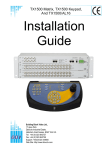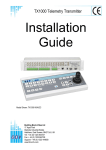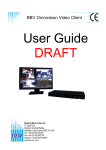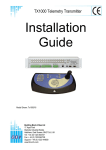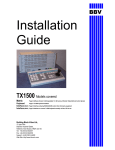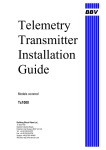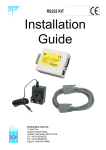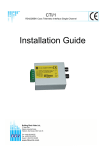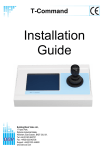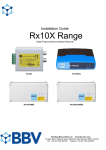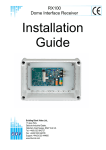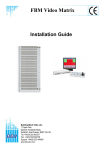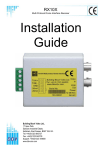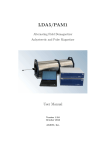Download BBV TX1500/BBUS-IF Installation guide
Transcript
TX1500 Matrix, TX1500 Keyboard, TX1500/AL16 and TX1500/BBUS-IF Installation Guide Building Block Video Ltd., 17 Apex Park Diplocks Industrial Estate, Hailsham, East Sussex, BN27 3JU UK. Tel: +44 (0)1323 842727 Fax: +44 (0)1323 842728 Support: +44(0)1323 444600 Web Site: http://www.bbvcctv.com Contents Unpacking Safety Precautions System Components 3 3 3 Description TX1500 components Product Codes 4 4 4 TX1500 System Example 5 BBUS control bus BBUS example wiring RS485 Telemetry port RS485 wiring diagrams 6 7 8 8, 9 Video Input Card Monitor Output Card Matrix ALARM 00 & relay connector 96 Camera subrack wiring Matrix Dianostics 10 11 11 12 13 TX1500/AL16 16 Input Alarm Card 14 Configuring the TX1500 System Basics Access Tables Alarm Menus Sequences Camera Types Vista Extended Commands Telemetrey Functions Set Password System Parameters System Parameters 2 15 16 17 18 19 20 21 22 23 24 25 Up-the-coax receiver programming 26 TX1500 USER GUIDE Selecting a Camera Selecting a Monitor 27 27 27 Moving a Camera Lens Keys Auxiliary Outputs 28 28 28 Go to Preset Position Programming a Preset Position 29 29 Starting a Preset Patrol Starting a Monitor Sequence Triangle/Relay Key Alarm Key 30 30 30 30 TX1500/KBD System Keyboard 31 TX1500/BBUS-IF Interface examples 32-34 TX1500 control protocol 35-37 TX1500 Manual V3.5 Dec 07.doc Page 2 of 40 TX1500 MATRIX UNPACKING Inspect the packaging for signs of damage. If damage has occurred, advise the carriers and/or the suppliers immediately. Unpack the units carefully and check that all the items are present and correct. SAFETY PRECAUTIONS All normal safety precautions as laid down by British Standards and the Health and Safety at Work Act (or the relevant National safety legislation if installing in a country outside the U.K.) should be observed, and servicing should be referred to qualified service personnel. SYSTEM COMPONENTS Each complete system will comprise of at least the following: 1 x TX1500 video matrix enclosed in a 19” sub rack. 1 x TX1500/KBD system keyboard or TCommand Touch Screen keyboard 2 x RJ45 straight patch cables 2 x RJ45 breakout boxes with self adhesive mounting pad 2 x 9Vdc 500mA power supply (1 for the matrix and 1 for the keyboard) TX1500/32/8 matrix Standard TX1500/KBD System Keyboard Optional T Command Touch Screen Keyboard TX1500 Manual V3.5 Dec 07.doc Page 3 of 40 TX1500 MATRIX OVERVIEW The TX1500 is a video matrix and telemetry control system offering control of up to 96 cameras from 4 control positions. Eight monitor outputs are provided with monitors 1,2,3 & 4 having on screen display. BBV & VISTA up-the-coax and BBV 485 & VISTA 485 linked receivers and domes can be controlled when viewed on any monitor. Pelco and VCL up-the-coax control is limited to monitors 1-4. Site alarms and contacts are handled with alarm cards, each providing 16 inputs. Up to 6 alarm cards can be linked into the TX1500 system either locally or remotely offering 96 alarm inputs The TX1500/BBUS-IF interface, which appears as another keyboard, gives off-site control, via video/data transmission equipment, and local control from PC and other equipment. The interface can be controlled using either the TX1000 or TX1500 control protocol via either RS232 or RS422/485. The TX1500 matrix communicates with all keyboards, alarm cards and BBUS-IF interfaces via a polled 4-wire multidrop RS422 control bus named BBUS. The matrix itself is in a subrack which can be fitted to a 19” rack using supplied ‘ears’ that can be mounted on the front or rear face of the subrack. By fitting the ears on the back of the subrack, it can also be wall mounted. Alarm cards, BBUS-IF and StarCards are supplied in 1U sub racks as standard or can be fitted into the subrack with the matrix if specified when ordering. Larger subracks than standard can be supplied if specified when ordering. PRODUCT CODES TX1500/16/8 16 camera, 8 monitor matrix inc keyboard (supplied in 3U subrack) TX1500/32/8 32 camera, 8 monitor matrix inc keyboard (supplied in 3U subrack) TX1500/48/8 48 camera, 8 monitor matrix inc keyboard (supplied in 5U subrack) TX1500/64/8 64 camera, 8 monitor matrix inc keyboard (supplied in 5U subrack) TX1500/80/8 80 camera, 8 monitor matrix inc keyboard (supplied in 7U subrack) TX1500/96/8 96 camera, 8 monitor matrix inc keyboard (supplied in 7U subrack) TX1500/KBD keyboard with 3-axis joystick TX1500/AL16 16 input alarm card, volts free normally closed inputs TX1500/BBUS-IF BBUS Interface to allow control from a PC or other 3rd party equipment STARCARD StarCard with 8 x RS422/485 outputs to allow star wired telemetry STARCARD/CONVERTER As STARCARD with built in protocol conversion to allow control of domes etc. EXPANDING AN EXISTING SYSTEM on site (maximum of 96 camera inputs) Camera Inputs 32 48 64 80 96 Number of video input cards 2 3 4 5 6 Minimum subrack Size 3U 5U 5U 7U 7U Larger subracks can be ordered with the product code shown below. All the cards from the existing subrack must be transferred to the new subrack. Note all the external connections to aid re-commissioning the system. PRODUCT CODES TX1500/EXP16(17-32) TX1500/EXP16(33-48) TX1500/EXP16(49-64) TX1500/EXP16(65-80) TX1500/EXP16(81-96) 3U 5U 7U 16 video input card to expand from a 16 camera to 32 camera system 16 video input card to expand from a 32 camera to 48 camera system 16 video input card to expand from a 48 camera to 64 camera system 16 video input card to expand from a 64 camera to 80 camera system 16 video input card to expand from a 80 camera to 96 camera system TX1500/3U-SUBRACK TX1500/5U-SUBRACK TX1500/7U-SUBRACK TX1500 Manual V3.5 Dec 07.doc Page 4 of 40 TX1500 MATRIX Rx100 + dome camera Rx200 + panning camera Rx300 + pan/tilt camera Rx400P + preset pan/tilt camera STATIC Rx400DC Rx45X Rx55X + DC preset pan/tilt camera Multi-protocol + AC Preset pan/tilt camera Multi-protocol + DC preset pan/tilt camera video in - coax RS485 StarCard 8 outputs TX1500/16/8/16AL Matrix twin STP RJ45 Breakout Box TX1500/KBD TX1500/KBD TX1500 Manual V3.5 Dec 07.doc Page 5 of 40 TX1500/KBD TX1500 MATRIX EXAMPLE BBUS CONTROL BUS The TX1500 communicates with all keyboards, alarm cards and BBUS-IF interfaces via a polled 4 wire multidrop RS422 control bus named BBUS. All the units are equipped with standard RJ45 connectors allowing cat 5 patch cables to be used to connect over short distances. On the larger sites RJ45 break out boxes are used to link between cat 5 cables and good quality screen twin twisted pair data cable. Suitable types are the following Belden cables: 9842, 9829, 8162, 8132. 4 = TxA from MONITOR CARD TxB from MONITOR CARD = 5 (BLUE) (BLUE/WHITE) RxB to MONITOR CARD = 6 3 = RxA to MONITOR CARD (GREEN) (GREEN/WHITE) (0V) SCREEN = 7 2 = DO NOT USE (+V) (0V) SCREEN = 8 1 = DO NOT USE (+V) Fig 5. BBUS - RJ45 breakout box connector, MONITOR CARD end of BBus. BBUS maximum distance 1200M end-to-end BLUE/WHITE Tx Data (FROM CPU) BLUE GREEN Rx Data (TO CPU) GREEN/WHITE SCREEN SCREEN SCREEN Alarm card BBUS Un-Terminated Switch 7-8 OFF 0V +9Vdc 0V +9Vdc Card 1 alarm 1-16 ON 1 2 3 4 5 6 7 8 RJ45 patch cable max length = 2M Keyboard 1 BBUS Un-Terminated 1-5 = Keyboard Address 6&7 = BBUS termination 8 = Program Key Enable Keyboard 2 BBUS Terminated ON ON 1 2 3 4 5 6 7 8 1 2 3 4 5 6 7 8 Fig 6. Keyboard BBUS wiring TX1500 Manual V3.5 Dec 07.doc V2 Page 6 of 40 TX1500 MATRIX SYSTEM BBUS WIRING EXAMPLES The following diagrams show examples of various wiring schemes. BBUS maximum distance 1200M ON ON ON ON ON 1 2 3 4 5 6 7 8 1 2 34 5 6 78 12 3 4 5 6 78 1 2 3 4 56 7 8 1 2 34 5 6 7 8 Matrix SW2 BBUS Termination ON Keyboard 1 BBUS Termination OFF PROGRAM Enabled Keyboard 2 BBUS Termination OFF PROGRAM Disabled Keyboard 3 BBUS Termination OFF PROGRAM Enabled Keyboard 4 BBUS Termination ON PROGRAM Enabled Fig 7. Example with all keyboards daisy chained from the TX1500 matrix using a single BBUS leg. ON 1 2 3 4 5 6 7 8 Matrix SW2 BBUS Termination OFF ON ON ON ON 1 2 3 4 56 7 8 1 2 3 4 5 6 7 8 12 3 4 5 6 78 1 2 3 4 56 7 8 Keyboard 1 BBUS Termination ON PROGRAM Enabled Keyboard 2 BBUS Termination OFF PROGRAM Disabled Keyboard 3 BBUS Termination OFF PROGRAM Enabled Keyboard 4 BBUS Termination ON PROGRAM Enabled BBUS maximum distance 1200M Fig 8. Example with all keyboards daisy chained from the TX1500 matrix using two BBUS legs. STARCARD ON 5 4 3 2 1 3/TRA -> 4 2/TRB -> 5 1 2 34 5 6 78 Matrix SW2 BBUS Termination ON 4/RA -> 6 5/RB -> 3 STARCARD to KEYBOARD maximum distance 1200M KEYBOARD ON ON ON ON 12 3 4 56 7 8 1 2 3 4 56 7 8 12 34 5 6 78 1 2 3 4 56 78 Keyboard 1 BBUS Termination ON PROGRAM Enabled Keyboard 2 BBUS Termination ON PROGRAM Disabled Keyboard 3 BBUS Termination ON PROGRAM Enabled Keyboard 4 BBUS Termination ON PROGRAM Enabled Fig 9. Use of a STARCARD to allow star wiring of keyboards. TX1500 Manual V3.5 Dec 07.doc Page 7 of 40 TX1500 MATRIX RS485 TELEMETRY OUT 4 = TxA to Telemetry Receiver RA(+) TxB to Telemetry Receiver RB(-) = 5 (BLUE/WHITE) (BLUE) DO NOT USE = 6 3 = DO NOT USE GROUND/SCREEN = 7 2 = DO NOT USE GROUND/SCREEN = 8 1 = DO NOT USE Fig 10. TELEMETRY – RJ45 breakout box connector. This port provides telemetry control via BBV RS485. Again a Cat 5 RJ45 patch cable and breakout box is used to connect the telemetry receivers via single twisted pair cable. It is possible to either wire the network in a daisy chained or star configuration using an optional RS485 star card. RS485 wiring configurations are shown below and on the following page. RS485 TELEMETRY WIRING CONFIGURATIONS Camera 1 Rx45X/55X Address 1 Keep stub length as short as possible Camera 2 Un-Terminated Camera 3 Un-Terminated Rx45X/55X Address 2 Keep stub length as short as possible Rx45X/55X Address 3 Camera 4 Un-Terminated Terminated Rx45X/55X Address 4 Keep stub length as short as possible RS485 Telemetry RS485 Telemetry RS485 Telemetry Maximum length of RS485 from Tx1500 to last receiver - 1200M Coax Coax Coax Rx457/557 RS485 connectors RJ45 patch cable DET AIL ED VIE T T G RR R R N A B D A B W T T G R R R R N A B D A B RJ45 breakout box screen screen TxB to RB (-) = 5 4 = TxA to RA (+) DO NOT USE = 6 3 = DO NOT USE SCREEN = 7 2 = DO NOT USE SCREEN = 8 1 = DO NOT USE Fig 11. Daisy Chained RS485 Telemetry Wiring TX1500 Manual V3.5 Dec 07.doc T T G R R R R N A B D A B Page 8 of 40 TX1500 MATRIX screen Camera 1 Camera 2 Rx45X/55X Address 1 Terminated Camera 3 Rx45X/55X Address 2 Terminated Camera 4 Terminated Rx45X/55X Address 3 Rx45X/55X Address 4 Terminated RS485 TELEMETRY 1200M Max RS485 TELEMETRY 1200M Max Coax RS485 TELEMETRY 1200M Max Coax RS485 TELEMETRY 1200M Max Coax RJ45 Patch Cable BBV Star Card T T G R R R R N A B A B D 12 3456 78 StarCard SW3 must be set to 4 wire as shown. TRB to RB TRA to RA DETAILE D VIEW Rx45X/55X Telem Conn S C R E E N StarCard Star output Fig 12. Star Wired Configuration using the optional BBV StarCard Camera 1 Rx45X/55X Address 1 Camera 2 Terminated Rx45X/55X Address 2 Camera 3 Terminated Camera 4 Terminated Rx45X/55X Address 3 Rx45X/55X Address 4 RS485 to each receiver Maximum 1200M screen T DE LE AI RS485 Maximum 1200M D VI EW 5 4 RJ45 patch cable From TX1500 TB(Pin 5) From TX1500 TA(Pin 4) 7 8 Screen RB RA TRA TRB GND MASTER RJ45 Breakout Box Fig 13. Use of StarCard mounted remotely, reducing cable runs TX1500 Manual V3.5 Dec 07.doc Page 9 of 40 TX1500 MATRIX Terminated VIDEO INPUT CARD The Video Input Card is used to connect 16 camera inputs to the TX1500. Systems larger than 16 cameras will use multiple cards. A board mounted DIL switch is used to set the card’s camera number range. Each input has a corresponding looping output on the lower BNC connector. The camera inputs are passively terminated at 75Ω and auto de-terminate when a BNC plug is connected to the looping output. Up to 6 cards can be connected in a matrix to control up to 96 cameras. 1 2 3 4 5 6 7 8 9 10 11 1 2 1 3 1 4 1 5 16 VIDEO INPUTS Video Input card Front Panel View Video bus PL4 PL3 PL6 Control bus J17 PL2 BBV SW1 PL1 PL5 LD1 00101 Top view of Tx1500 video input board PCB00101 The switches for each card will be set at the factory however if the system is to be upgraded then please set the new card(s) switches as shown below. SW1 Camera Range Camera 1 - 16 Camera 17 - 32 Camera 33 - 48 ON ON ON 1 2 3 4 5 6 7 8 1 2 3 4 5 6 7 8 1 2 3 4 5 6 7 8 Camera 49 - 64 Camera 65 - 80 Camera 81 - 96 ON ON ON 1 2 3 4 5 6 7 8 1 2 3 4 5 6 7 8 1 2 3 4 5 6 7 8 Video Input card SW1 address switch setting TX1500 Manual V3.5 Dec 07.doc Page 10 of 40 TX1500 MATRIX MONITOR OUTPUT CARD This card provides the 8 monitor outputs, BBUS, RS485 telemetry and a relay output. Internal switches are used during specific BBV tests that should not require on site adjustment. 1 2 3 4 5 6 7 8 MONITORS TELEMETRY B-BUS 12Vdc ALARM Monitor Output card Front Panel View PROG SW2 LINK PL1 LD5 LD4 LD6 PL2 LD2 01002 SW1 LD3 RS485 OUT L9 LD1 B-BUS Monitor Output card internal view LD1 STATUS – Front Panel indication of system and BBUS operation. Refer to page 16. Internal LEDs, LD2 – BBV debug use. LD3, 4, 5, 6 – ON whilst coaxial telemetry is transmitted to the camera For normal operation the internal switches must be as shown below: SW 1 ON SW 2 ON B -B U S R S 485 O N = T erm inated O F F = U n -term inated R S 485 T elem etry O N = T erm inated O F F = U n-te rm in ated 1 2 3 4 5 6 7 8 1 2 3 4 5 6 7 8 To reset system to factory defaults:- Power off the TX1500, set the switches as below and power up the TX1500. On screen instructions are displayed on monitor 1 output. SW1 Power Up Factory Reset SW2 ON ON 1 2 3 4 5 6 7 8 1 2 3 4 5 6 7 8 NOTE: The Power Up Factory Reset option will delete all TX1500 parameter programming. Contact BBV technical support for guidance. +44(0)1323 444600. 1 2 3 4 5 Alarm 00 input can trigger one of several actions, refer to page 19 Input from volts free, normally closed contacts NC NO COM CHANGEOVER RELAY operated by the triangle key Volts free contacts for low voltage switching only ALARM 00 TX1500 Manual V3.5 Dec 07.doc Page 11 of 40 TX1500 MATRIX 96 CAMERA SYSTEM SUBRACK CARD CONFIGURATION J9 PL1 L10 J11 L11 PL6 Video Input Card BBV Video Input Card PL4 PL3 PL6 Video Input Card BBV PL3 Video Input Card PL4 PL3 PL6 PL6 PL1 SW1 PL2 LD1 J17 SW1 LD1 J17 PL1 PL1 SW1 PL2 LD1 J17 SW1 PL2 LD1 J17 PL1 PL1 SW1 PL2 LD1 J17 PL1 SW1 01002 00101 PL5 00101 PL5 00101 PL5 00101 PL5 00101 PL5 PL5 00101 ON 12 3456 78 R I B B BBV O N PL4 J17 PL2 PL6 LD1 PL2 LD2 ON 12 34 56 78 Camera 81 - 96 PL3 R I B B BBV O N PL4 PROG LINK ON 12 3456 78 Camera 65 - 80 R I B B O N Video Input Card PL3 SW1 PL2 R I B B BBV O N PL4 SW2 Camera 33 - 48 R I B B O N Camera 49 - 64 R I B B O N BBV PL6 J8 Camera 17 - 32 R I B B O N Monitor Output Card PL3 B-BUS L9 LD3 LD5 J10 LD1 Camera 1 - 16 R I B B O N PL4 RS485 OUT ON 12 34 56 78 R I B B O N LD4 ON 12 3456 78 R I B B O N LD6 ON 12 34 56 78 R I B B O N R I B B O N Video Input Card Wiring and switch settings for Video Input cards and Monitor Output card. TX1500 Manual V3.5 Dec 07.doc Page 12 of 40 TX1500 MATRIX MATRIX DIAGNOSTICS The matrix STATUS led indicates system operation as follows: Flashing Dimly The matrix is powered with at least one keyboard connected. Use 58# to display the keyboard numbers that the matrix has detected on the BBUS. Mainly OFF, 1 second ON The matrix is powered with no keyboards connected. – If keyboards are connected then make sure that each keyboard address is unique between 0 – 3. Keyboards sharing an address will cause the matrix to ignore both keyboards with unpredictable results. OFF Either the matrix is not powered or has an internal fault. If the power supply seems fine then please contact technical support for further assistance. Several commands exist that allow on site diagnostics. These commands must be entered from keyboard 1 and display results on monitor output 1. 51# Display the matrix firmware version, number of resets and watchdog resets. TX1500 Version shows the matrix firmware version number ie 2.3 resets shows the number of times that the system has lost power or the menu has been accessed. watchdogs shows the number of times the matrix watchdog has reset the matrix. A high figure here can indicate that there may be interference or power fluctuations. 55# Coaxial telemetry on. With normal operation, the coaxial telemetry is only transmitted to a receiver whilst a camera is being controlled. After a short period the telemetry transmission is stopped. This is prevent interference to sync separators in DVRs etc. When trouble shooting telemetry problems the telemetry should be on all the time so the 55# command would be used and then the receiver CABLE and ERROR leds inspected. Pressing # again will stop the telemetry transmission. 56# Display the status of matrix switch SW1, the display shows a HEX number which corresponds to the switch settings for SW1. The number is displayed whilst the # key is pressed. Releasing the # key will clear the number from the screen. Number displayed 0 1 2 4 8 10 20 SW1 switch 1 - 6 OFF 1 ON 2 ON 3 ON 4 ON 5 ON 6 ON When more than 1 switch is ON then the number displayed will the sum of the values of all switches that are ON, ie. 1,2 ON, display shows 03, 1,2,3,4 ON displays 0F RS485 telemetry directly from the TELEMETRY port and should not normally be selected. 57# 58# Example numbers that could be displayed 0 = normal mode 1 = DIXONS mode – This is a special mode developed for DSG driving Mark Mercer Display the status of matrix switch SW2 as per 56#. 2A = SW2-2/4/6 ON = FACTORY INITIALISATION on a power up. This is used to clear any programming and load default values. Useful if the matrix has had a corrupted programming. Once powered up turn all SW2 switches OFF again to prevent further accidental initialisations. Display number of keyboards or BBUS/I-F with addresses connected to the matrix along with the software version of each keyboard or BBUS/I-F. TX1500 Manual V3.5 Dec 07.doc Page 13 of 40 TX1500 MATRIX TX1500/AL16 - 16 ALARM INPUT CARD Each alarm card provides 16 individual normally closed volts free alarm inputs. The card communicates via the BBUS with the monitor output card. Power is supplied either via the BBUS interface when the alarm card is mounted in the TX1500 subrack or via an external 9Vdc supply when mounted remotely. NOTE: Only 1 alarm card can be powered from the BBUS port. The power led is used as a status indication and shows the following: Mainly ON, flashing OFF when the alarm card is polled, approx 2-3 times every second. (NORMAL) OFF permanently – alarm card not powered or faulty. ON permanently – Not polled by MONITOR card, BBUS cable faulty or ALARM card faulty. ALARM INPUT 1-8 ALARM INPUT 9-16 B-BUS 12Vdc OUTPUTS Fig 23. Alarm card front panel view 02002 J1 RY2 SW1 RY1 LD1 B-BUS Fig 24. Alarm card internal view SW1 is used to set the alarm card address as follows: Card 1 alarm 1-16 Card 2 alarm 17-32 Card 3 alarm 33-48 ON ON ON 1 2 3 4 5 6 7 8 1 2 3 4 5 6 7 8 1 2 3 4 5 6 7 8 Card 4 alarm 49-64 Card 5 alarm 65-80 ON ON Switches 7 & 8 BBUS RS485 Termination ON = Terminated OFF = Un-terminated Card 6 alarm 81-96 Must be ON if the alarm card is at the end of line and OFF otherwise. ON Alarm card 6 shown as end of line. 1 2 3 4 5 6 7 8 1 2 3 4 5 6 7 8 1 2 3 4 5 6 7 8 Fig 25. Alarm card SW1 address switch settings Each alarm card has two single pole changeover relays called Relay 1 and Relay 2. These relays can be driven manually and also from alarm activations. The system relay numbers are assigned as follows: Alarm Card 1 2 3 4 5 6 Relay 1 1 3 5 7 9 11 Relay 2 2 4 6 8 Note: alarm card relay 1 cannot be controlled from the keyboards as it is an 10 alarm output contact that changes state when any alarm becomes active. 12 This allows it to be used to switch a VCR into realtime recording etc. The duration is set in the matrix menu. – Relay 1 Time TX1500 Manual V3.5 Dec 07.doc Page 14 of 40 TX1500/AL16 16 INPUT ALARM CARD CONFIGURATION USING THE TX1500 MENUS NOTE only keyboard 1 can access the TX1500 system menu and only monitor 1 can display the menu. Out of the box the TX1500 is configured to control BBV coaxial telemetry on all cameras and all keyboards can control all the monitors and cameras. The TX1500 menu system allows the unit to be configured to your customer’s site requirements. To access the menu select monitor 1 by pressing ‘1’ ‘MON’ and use keyboard 1. Press and hold the ‘PROGRAM’ key for 2-3 seconds and the following screen will be displayed and the ‘PROGRAM’ led is lit. If the menu is not displayed then check that the program key is enabled on the keyboard by turning switch 8 ON. Press for 2 seconds PROGRAM Enter Pin Number * * * * * * The menu is displayed and the PROGRAM led is lit. + or - = Enter Key Joystick to Navigate Press Program to exit PROGRAM Enter the six digit PIN using keys 0 – 9. The default PIN is 999999 Exit Use the joystick left and right if a digit is entered incorrectly. The TX1500 Main Menu is displayed if the PIN is correct otherwise the TX1500 reverts to normal control. TX1500 - Main Menu System Basics Access Tables Alarm Menus Sequences Camera Types Set Passwords System Parameters Exit To navigate through the menu, use the joystick and either the +/- keys to toggle a value or the numeric keys 0-9 if a value is required. To exit the menu press the PROGRAM key at any point. PROGRAM press + to select Each menu item is described on the following pages TX1500 Manual V3.5 Dec 07.doc Page 15 of 40 MATRIX PROGRAMMING/USER GUIDE SYSTEM BASICS This example screen shows the settings for a site with 10 cameras, 2 keyboards and a single alarm card with 16 alarm inputs. System Basics Maximum Camera number: Specifies how many video inputs are connected to the matrix and prevents switching to non-existent cameras. Valid values are 01 96 Maximum Camera number 10 Maximum Alarm number 16 Text on Monitors 1+2+3+4 Display Line 9 System Type PAL Number of Keyboards 2 Return Maximum Alarm number: Specifies how many alarm inputs are connected to the matrix. Set as below:Alarm cards 0 1 2 3 4 5 6 Maximum Alarm number 0 16 32 48 64 80 96 Text on Monitors: Monitor outputs 1 – 4 display the camera number, monitor number and other messages. Text on these monitors can be disabled by using the + or – key to cycle through options. Display Line: The TX1500 status line can be moved up or down on the screen to prevent the TX1500 text from being overwritten by the text from other components of the system. Use +/- to cycle through values. 0 being the top of the screen and 10 the bottom of the screen. System Type: Sets the CCTV video standard as PAL or NTSC. Use the +/- keys to select the standard. Normally PAL in the UK. Number of Keyboards: Sets the number of keyboards connected to the matrix Return: Returns to the TX1500 Main Menu. TX1500 Manual V3.5 Dec 07.doc Page 16 of 40 MATRIX PROGRAMMING/USER GUIDE ACCESS TABLES One of the advanced features of the TX1500 system is the ability to prevent specific cameras from being displayed on specific monitors and to prevent specific keyboards from moving cameras. The Access Table screen is used to program which monitors each keyboard can control. A setting of ‘Y’ is used if the keyboard is allowed to control a monitor and ‘N’ to prevent control. This screen shows the settings for a site with two keyboards. Each keyboard has it’s own monitor and is locked out of controlling the other keyboard’s monitor. Access Table Keyboard to Monitors 1 2 3 4 Tx 1500 v6 Tx 1500 v6 Not Fitted Not Fitted 1 Y N N N 2 N Y N N 3 N N N N 4 N N N N 5 N N N N 6 N N N N 7 N N N N 8 N N N N i.e. Keyboard 1 can control monitor 1 ONLY Keyboard 2 can control monitor 2 ONLY Pressing the +/- keys will toggle the value of each monitor between Y and N. NB: Keyboard 1 can always control monitor 1 as this is used to setup the matrix. Return On power up the matrix interrogates devices on the BBUS and all control devices are displayed on this screen. Recognised control devices are:-. Displayed TX 1500 TCommand 232 I/F Description Standard TX1500 joystick keyboard Touch Screen keyboard BBUS Interface allowing control from PC and from remote sites etc. Allocating cameras to monitors and keyboards is programmed from the Camera Types screen. TX1500 Manual V3.5 Dec 07.doc Page 17 of 40 MATRIX PROGRAMMING/USER GUIDE ALARM MENUS Alarm handling of the TX1500 is programmed from the Alarm Menu screens. Up to four actions can be carried out following each alarm activation. Eg four cameras could move to preset positions to triangulate onto an event. On selection of Alarm Menus the following screen is displayed This example shows a system with a single 16 input alarm card. You have 16 alarms enabled and connected Edit Alarm number 00 Input Action Disable Alm Alarm Beep Time 6 Seconds Alarm Stack Automatic Relay 1 Time 60 Seconds The TX1500 will display the total number of alarms that can be programmed based on the Maximum Alarm number set in the System Basics menu. Return Input Action: Sets the action for the ALARM 00 input on the matrix monitor board. Use +/- to cycle through the options. No Action – ALARM 00 is not used. Disable Alm – is used to disable all alarms when ALARM 00 is shorted to GND. Alarm 00 – ALARM 00 is used as an alarm input in addition to the TX1500/AL16 alarm card inputs. NOTE: Always handled in ‘AUTOMATIC’ mode, regardless of ‘Alarm stack’ setting. Alarm Beep Time: Number of seconds that all the keyboards ‘beep’ following an alarm input. Use +/- to cycle through the values. 0, 4, 6, 8, 10, 15, 20 Seconds Alarm Stack: The matrix alarm handling can be automatic, ie the system will drive cameras to presets as alarms occur or require an operator input before the alarm is actioned. Use the +/- to toggle between Automatic and Manual. Automatic – Alarm activations are handled automatically Manual – The ALARM key must be pressed to acknowledge an alarm activation Relay 1 Time: The number of seconds that the Relay 1 output of alarm card 1 is active following any alarm. Use +/- to cycle through the various time delays. 10, 30, 60, 90, 120, 150, 200 or 250 seconds. Enter the 2 digit alarm number you wish to program using the 0-9 keys. Eg enter 01 for alarm 1. The following screen will then be displayed. See the relay number mentioned on page 17. Alarm Act 1 kbd cam mon pre time 1 01 1 01 30s No Act 1 01 1 00 30s No Act 1 01 1 00 30s No Act 1 01 1 00 30s Return Exit next prev TX1500 Manual V3.5 Dec 07.doc Each of the four actions can allow a camera to be moved to a preset position and displayed on a monitor output. In addition, if the monitor was sequencing before the alarm occurred, after ‘time’ seconds the sequence is re-started. If alarms are taken into the local alarm input of a telemetry receiver that supports local alarms, ie Rx100/Rx400DC/Rx45X/Rx55X, ‘pre’ must be set to 00 as the preset will depend on the receiver alarm input. (See the receiver manual for more details on local alarms.) This simple example shows alarm 1 moving camera 1 to preset 1 and display on monitor 1. next and prev allow setting the alarm actions for the next and previous alarm inputs. Page 18 of 40 MATRIX PROGRAMMING/USER GUIDE SEQUENCES Each of the 8 monitor outputs of the TX1500 can sequence between all or specific cameras. Each camera can be individually added or removed from each monitor sequence. For example, in a retail environment public store monitors are prevented from displaying sensitive areas of the store whilst monitors in the security office can sequence all cameras. Sequence Setup Selection Cameras Cameras Cameras Cameras Cameras Cameras Cameras Cameras Return 01 09 17 25 33 41 49 57 - If a camera greater than the Maximum Camera Number is added to a sequence this camera will be ignored when the sequence is running. 08 16 24 32 40 48 56 96 Selecting Cameras 01 – 08 will display the following screen monitor sequence setup cam 1234 5678 1 2 Second YYYY YYYY 2 5 Second YYYY YYYY 3 15 Second YYYY YYYY 4 20 Second YYYY YYYY 5 25 Second YYYY YYYY 6 30 Second YYYY YYYY 7 Full Rand YYYY YYYY 8 Random YYYY YYYY Return Menu Next8 Sequence types: 2/5/15… Second Random Full Rand Monitors 1 to 8 are shown with monitor 1 the top line and monitor 8 the bottom line. The first item is the type of sequence or the dwell time if running a standard sequence. The screen on the left shows all the variants of sequences and dwell times. – standard sequence with a dwell time before displaying the next camera. – The cameras are sequenced as above from lowest to highest but with a random dwell time between each camera. – In Full Random the monitor will display a completely random camera for a random period of time. This is useful for public display monitors on shop floor to prevent shoplifters remembering the displayed sequence. A camera will be in a specific monitor’s sequence if a Y is displayed or be skipped if an N is displayed. Use the + or – keys to toggle between Y and N. Next8 displays the next bank of 8 cameras. TX1500 Manual V3.5 Dec 07.doc Page 19 of 40 MATRIX PROGRAMMING/USER GUIDE CAMERA TYPES These screens are used to set the type of telemetry for each camera and which monitors and keyboards are allowed to view and control each camera. Camera Setup Selection Cameras Cameras Cameras Cameras Cameras Cameras Cameras Cameras Return 01 09 17 25 33 41 49 57 - The cameras are again displayed in banks of 8 as shown on the following screen: 08 16 24 32 40 48 56 96 Start at Cameras 01 – 08 to display the setup screen Camera 01-08 01 BBV coax 02 BBV coax 03 Static 04 BBV coax 05 BBV 422 06 BBV coax 07 Unused 08 Unused Return Kbd Monitor 1234 12345678 YYYY YYYYYYYY YYYY YYYYYYYY YYYY YNYYYYYY YYYY YYYYYYYY YNNN NYNNNNNN YYYY YYYYYYYY YYYY YYYYYYYY YYYY YYYYYYYY Menu Next8 This example shows Camera 1,2,4 & 6 with coax telemetry and able to be viewed on all monitors and controlled from all keyboards. Camera 3 is a static camera that can be viewed on all monitors apart from monitor 2. Camera 5 is driving via BBV RS422 and can only be viewed on monitor 2 and controlled by keyboard 1. Cameras 7 & 8 are unused. The choices for camera type are: BBV coax BBV 422 VCL coax PEL coax VISTA cx - Standard BBV up-the-coax telemetry (Rx100/200/300/400P/400DC/Rx45X & Rx55X) - BBV RS422 telemetry also used when driving additional protocols via a StarCard/converter - Control only available on monitors 1-4 this is a limited implementation of the Protocol - Control only available on monitors 1-4 this is a limited implementation of the Protocol - Supports VISTA POWER DOME and other Domes VISTA range. Contact support for more information VISTA TP - Supports VISTA POWER DOME and other Domes VISTA range. Contact support for more information STATIC - Telemetry is disabled Unused – The camera is not fitted and can’t be viewed manually or in a sequence. Other types may be selectable, please check with BBV before choosing these. BBV coax would be used to control the existing range of BBV up-the-coax receivers. Rx100 for dome control. Rx200/300/400P for AC heads, Rx400DC for high/variable speed 24Vdc heads. The maximum distances that should be used are: 250M of RG59 and 500M of CT125 grade cable. BBV 422 is used to drive the new advanced range of addressable BBV receivers that are controlled using two wire RS422. The RX45X is used when driving AC pan/tilt heads and the RX55X is used for high/variable speed 24Vdc heads. Both receivers offer additional features including an On Screen Display with an advanced menu system, 8 local alarm inputs, wide input supply, DIP switch addressable allowing either star or daisy chained wiring. Selected 3rd party domes and telemetry receivers can be controlled via RS422 and a BBV STARCARD/CONVERTER. The camera type must also be set to BBV 422. Full details can be found on the BBV web site www.bbvcctv.com Kbd: If a keyboard is allowed to control the camera, select Y, or if the keyboard can only view but not control the camera, select N. Monitor: Select Y if the camera can be displayed on each monitor or N if not. This allows cameras to be hidden from specific monitors/operators. TX1500 Manual V3.5 Dec 07.doc Page 20 of 40 MATRIX PROGRAMMING/USER GUIDE VISTA Coax Extended Commands on the Tx1500Matrix Supports 86 Presets Presets 1 thought to 88 except 33 & 34 Keyboard 91 Preset 92 Preset 93 Preset 94 Preset VISTA COAX Command RUN Learn 1 RUN Learn 2 Program Learn 1 Program Learn 2 Keyboard VISTA COAX Command 1 Patrol RUN Tour 1 2 Patrol RUN Tour 2 Iris Open Enter Iris Close ESC 1# 1# 1# Enter Dome Menu (min idome) VPD-4WP-P-C/L Enter Dome Menu (VISTA POWER DOME) DomeMENUPassword“1234” On the VPD-4WP-P-C/L if you press the Autopan Key nothing will happen until you either: i) Press the Iris close and it will start a dome scan if saved. ii) Use the joystick and it will go in to the menu Password screen. RS422 (simplex) TELEMETRY OUT TxB to Dome RB(-) = 5 4 = TxA to Dome RA(+) DO NOT USE = 6 3 = DO NOT USE SCREEN = 7 2 = DO NOT USE SCREEN = 8 1 = DO NOT USE 4 = TxA to Dome RA(+) TxB to Dome RB(-) = 5 DO NOT USE = 6 3 = DO NOT USE DO NOT USE = 7 2 = DO NOT USE SCREEN = 8 1 = DO NOT USE G N D R A R B Dome 1 G N D R A R B Dome 2 G N D R A R B Dome 3 RJ45 breakout box This port provides telemetry control via BBV RS422 (simplex). A Cat 5 RJ45 patch cable and breakout box is used to connect the VISTA DOME CAMERAS via single twisted pair cable. It is possible to either wire the network in a daisy chained or star configuration using an optional RS422 Starcard. TX1500 Manual V3.5 Dec 07.doc Page 21 of 40 MATRIX PROGRAMMING/USER GUIDE Telemtry Function Protcoal BBV coax BBV485 VCL coax Pelco coax VISTA coax VISTA 485 TP Maximun cable Distance 250M RG59 500M CT125 1200M BELDEN 8723 250M RG59 275M CT125 250M RG59 275M CT125 250M RG59 275M CT125 1200M BELDEN 8723 1# REFER TO RECEIVER MANUAL REFER TO RECEIVER MANUAL N/A ENTER DOME MENU ENTER DOME MENU ENTER DOME MENU 2# REFER TO RECEIVER MANUAL REFER TO RECEIVER MANUAL N/A 180 FLIP EXIT DOME MENU EXIT DOME MENU 3# REFER TO RECEIVER MANUAL REFER TO RECEIVER MANUAL N/A N/A AUTOPAN Menu Esc Key no Shift 4# REFER TO RECEIVER MANUAL REFER TO RECEIVER MANUAL N/A SOFT RESTART RESET DOME Menu Esc Key with Shift 5# N/A N/A N/A N/A N/A Freeze off 6# N/A N/A N/A N/A N/A Freeze on 7# N/A N/A N/A N/A N/A Color Mono toggle 8# N/A N/A N/A N/A N/A 180 Flip 9# N/A N/A N/A N/A N/A Auto Focus toggle 10# N/A N/A N/A N/A N/A Auto Iris toggle Number of Presets Spproted 16 32 99 32 32 GOTO 33 PRESET N/A N/A 180 FLIP N/A 86 1 thought to 88 except 33 & 34 N/A N/A GOTO 80 PRESET N/A N/A AUTOFOCUS ON N/A N/A N/A GOTO 81 PRESET N/A N/A AUTOFOCUS OFF N/A N/A N/A GOTO 91 PRESET N/A N/A N/A N/A RUN Learn 1 N/A GOTO 92 PRESET N/A N/A N/A N/A RUN Learn 2 N/A GOTO 93 PRESET N/A N/A N/A N/A Program Learn 1 N/A GOTO 94 PRESET N/A N/A N/A N/A Program Learn 2 N/A GOTO 99 PRESET START AUTOPAN START AUTOPAN START AUTOPAN START AUTOPAN N/A N/A Iris Open N/A ENTER WHEN IN THE MENU N/A ENTER WHEN IN THE MENU ENTER WHEN IN THE MENU N/A Iris Close N/A N/A N/A N/A ESCAPE N/A TX1500 Manual V3.5 Dec 07.doc Page 22 of 40 MATRIX PROGRAMMING/USER GUIDE SET PASSWORD TX1500 version 3.5 Change Pin Number New Pin Number ****** Confirm Number ****** Download Upload Initialise System Return Exit The default menu password of 999999 can be changed using this screen. MAKE A NOTE OF THE NEW PIN. The matrix software version is displayed at the top of the screen. Select the New Pin Number area and type the new PIN. Move to the Confirm Number area and retype the PIN. If the numbers match then a confirmation screen is displayed. Select EXIT to return to normal operation. Upload This feature stores the system parameters onto a pc to allow for backup. Data is transferred via the telemetry port. Connection to a normal serial com port is made through a BBV TXLD. PC application software is called ‘UP_DOWN_GUI’ and is available on the BBV website at www.bbvcctv.com or contact support Download This feature restores the system parameters from a pc. Data is transferred via the telemetry port. Initialise System: Cause the entire matrix programming to be deleted and default settings used. This function must be used with great care, as ALL programming will be lost. Plan view of TXLD PCB PCB0313 Iss2 BBV LD2-RX BROWN GREEN TO TELEMETRY PORT GREEN/WHITE BLUE GND TB/-(OUT) TA/ +(OUT) RA/+(IN) RB/-(IN) RX LO HI TX BLUE/WHITE LD1-TX TO PC COM PORT RS232 in DB9M 2 = RXD 5 = GND 9V SUPPLY IN RJ45 PATCH CABLE UPLOAD/DOWNLOAD CONNECTION TO PC TX1500 Manual V3.5 Dec 07.doc Page 23 of 40 MATRIX PROGRAMMING/USER GUIDE SYSTEM PARAMETERS Used to program additional settings as follows: System Parameters System Parameters 2 Menu Timeout Program Timeout Lockout Delay Relay 0 Action 60 Seconds 20 Seconds 10 Seconds Latching Return System Parameters 2: Displays the 2nd page of system parameters. Menu Timeout: Number of seconds of inactivity before the menu is automatically exited. Use +/- to cycle through values. 15, 20, 40, 60, 80, 100, 120, 150, 180, 200 or 250 seconds. Program Timeout: Number of seconds the keyboard will stay in programming mode after the PROGRAM key is pressed. This is to prevent preset positions from being overwritten accidentally. Use +/- to cycle through values. 15, 20, 40, 60, 80, 100, 120, 150, 180, 200 or 250 seconds. It is recommended that a short time is selected. Lockout Delay: Number of seconds that the PTZ control of a camera is locked out after the last movement command. Used to prevent two keyboards from ‘fighting’ for control of the same camera. Use +/- to cycle through values. 3, 5, 8, 10, 12, 15, 20, 30, 40, 60, 80, 100 or 250 seconds. 10 seconds would be an appropriate value. Relay 0 Action: Latching – Pressing the keyboard’s TRIANGLE key will toggle the state of the monitor output card relay. Momentary – The relay will switch whilst the TRIANGLE key is pressed and switch back again when the key is released. TX1500 Manual V3.5 Dec 07.doc Page 24 of 40 MATRIX PROGRAMMING/USER GUIDE SYSTEM PARAMETERS 2 Used to program additional settings as follows: System Parameters 2 Bump Cameras Return to patrol Priority Keyboard off off off Startup Actions Monitors in sequence None Return Bump Cameras: Selects the keyboard(s) that will remove the current camera from other monitors when controlled manually. This is to prevent, for example, public display store monitors from displaying cameras that are following a suspect. Use +/- to cycle through options:Off, Kbd 1, Kbd 2, Kbd 1 + 2, Kbd 3, Kbd 4, Kbd 1 + 2 + 3, Kbd 1+2+3+4 Return to patrol: If set to on, the current camera will start a preset patrol 1, if supported, when another camera is selected. This is useful for a system that has several cameras that should run preset patrols all the time that they are not controlled manually. Priority Keyboard: A keyboard can be set that can take control of cameras at any time and is not locked out by other keyboards. Startup Actions – Monitors: This option allows selected monitors to resume sequence should the system power fail and restore. Use +/- to cycle between the monitor choices. None, 8, 78, 678, 5678, 45678, 345678, 2345678, or 12345678. TX1500 Manual V3.5 Dec 07.doc Page 25 of 40 MATRIX PROGRAMMING/USER GUIDE UP-THE-COAX RECEIVER SPECIFIC PROGRAMMING To program specific features of Rx100/200/300/400P/400DC up-the-coax receivers, the camera type must be set to BBV COAX. Press and hold the ‘#’ key and tap the PROGRAM key to display the options. The PROGRAM key must be enabled in the keyboard using SW1 switch 8 ON which is the factory default setting. 1 Program Preset 01-16 Enter 01 – 16 to program this preset position. This is a legacy function to program a preset position and the preferred method is described on page 25. 2 Self Test Receiver This will start the remote self test function, i.e. left/right/up/down etc on BBV up-the-coax receivers only. 3 Set Iris Level Used with Rx300 Rx400P and Rx400DC to set the iris override output if fitted. 4 Erase Preset 01-16 Used to erase a preset from an RX100, RX400P or RX400DC. Enter 01 – 16 to erase the preset position. 5 Remove Preset Patrol 1 Enter 01 – 16 to remove the preset from preset patrol 1 with RX100, RX400P and RX400DC receivers 6 Remove Preset Patrol 2 As above but removes the preset position from patrol 2 7 Change Patrol 1 Time Used to set the dwell time for patrol 1. 01 = RANDOM, 02 = 12 seconds, 03 = 24 seconds etc up to 16 = 180 seconds when used with Rx100, Rx400P and Rx400DC receivers. 8 Change Patrol As above but relates to preset patrol 2. The menu will timeout and the PROGRAM key LED will turn OFF after several seconds to prevent accidental reprogramming of the receiver. TX1500 Manual V3.5 Dec 07.doc Page 26 of 40 MATRIX PROGRAMMING/USER GUIDE TX1500 USER GUIDE Monitor Number Monitor outputs 1,2,3 & 4 have an On Screen Display as shown on the left. Current Camera Number The Monitor number along with current Camera number is shown permanently. Keyboard Number driving camera Kbd is displayed whenever a keyboard is driving a camera. Mon 1 Cam 01 Kbd 1 Monitor outputs 5,6,7 & 8 are not equipped with On Screen Displays and are generally used as spot, park or public display monitors. SELECTING A CAMERA Use the number keys followed by the CAMERA key. If the keyboard AND monitor are allowed to display the camera then the current monitor will now display this camera. If not then the command is ignored. SELECTING A MONITOR Use the number keys followed by the MONITOR key. If the keyboard is not allowed to control this monitor then the command is ignored. Otherwise the keyboard can now control the camera displayed on the new monitor TX1500 Manual V3.5 Dec 07.doc Page 27 of 40 MATRIX PROGRAMMING/USER GUIDE MOVING A CAMERA JOYSTICK The joystick is used to pan and tilt the camera and drive the zoom. Moving the joystick left and right will pan the camera and the joystick up and down will tilt the camera. Rotating the joystick knob clockwise will zoom the lens IN and the knob anti-clockwise will zoom the lens OUT. The joystick gives variable speed control lens moving rotating LENS KEYS These keys are used to zoom and focus the lens and alter the iris if that function has been provided. Press a key for the desired function and release to stop. AUXILIARY OUTPUTS The WASH key is used to wash the camera housing’s glass if the feature has been provided. The WIPER key is used to toggle the camera housing’s wiper ON/OFF The function of the AUTOPAN key will vary depending upon the camera being controlled but mainly is used to make the camera either pan from end stop to end stop or to run a preset patrol. Moving the joystick left or right will turn autopan off. The LIGHTS key is used to toggle any lights ON/OFF TX1500 Manual V3.5 Dec 07.doc Page 28 of 40 MATRIX PROGRAMMING/USER GUIDE GOTO PRESET POSITION Use the number keys followed by the PRESET key. Preset positions are only available on moving cameras that are equipped for presets. Most will accept presets 1 – 16 although the TX1500 supports preset positions up to 99. This should be checked with your installing company. PROGRAMMING A PRESET POSITION Press the PROGRAM key to turn the PROGRAM key LED ON. The unit is now in preset programming mode. If the LED doesn’t light then this keyboard has been prevented from programming presets by the installation company. Use the number keys followed by the PRESET to program the new preset position. TX1500 Manual V3.5 Dec 07.doc Page 29 of 40 MATRIX PROGRAMMING/USER GUIDE key STARTING A PRESET PATROL Press either 1 or 2 followed by the PATROL key. The PATROL key LED will be ON whilst the current camera is running a preset patrol. To stop the camera from patrolling, move the joystick. The PATROL key LED will now be OFF. As with presets, patrols are only available on moving cameras that are equipped for presets. Certain dome cameras offer enhanced patrol features that will be covered in the product addendum sheet for each specific dome type. STARTING A MONITOR CAMERA SEQUENCE Pressing the SEQ key will start a camera switching sequence on the current monitor. The SEQ key LED indicates if the current monitor is running a sequence. Each monitor can sequence individually and simultaneously. The monitor sequence is programmed by the installation company using the system configuration menu. To stop the sequence either press the SEQ key again to toggle the LED OFF or select another camera. TRIANGLE / RELAY KEY Use the TRIANGLE key to operate the TX1500 change over relay on the monitor out card. This can be used for a variety of purposes. Your installation company will inform you of the specific function for your site. The relays on each alarm card can also be switched as follows: 2 TRIANGLE – relay 2 alarm card 1 3 TRIANGLE – relay 1 alarm card 2 4 TRIANGLE – relay 2 alarm card 2 5 TRIANGLE – relay 1 alarm card 3 6 TRIANGLE – relay 2 alarm card 3 7 TRIANGLE – relay 1 alarm card 4 8 TRIANGLE – relay 2 alarm card 4 9 TRIANGLE – relay 1 alarm card 5 10 TRIANGLE – relay 2 alarm card 5 11 TRIANGLE – relay 1 alarm card 6 12 TRIANGLE – relay 2 alarm card 6 ALARM KEY If the system has been configured for KEY PRESS alarms by the installation company, following a site alarm the ALARM key LED will be ON, the alarm monitor will display ‘alarm’ and the alarm keyboard will beep. The alarm is acknowledged by pressing the ALARM key. The alarm monitor/s will display the camera/s programmed for this alarm. TX1500 Manual V3.5 Dec 07.doc Page 30 of 40 MATRIX PROGRAMMING/USER GUIDE TX1500/KBD - System Keyboard This keyboard provides control of the system and any cameras connected to the matrix. The keyboard communicates through an RJ45 connector using BBV TX1500 protocol at 9600 baud on an RS422 link. An internal 8 way DIP switch is used to set the keyboard address, RS422 termination and PROGRAM key enable/disable. Each keyboard must have a unique address between 1 and 4. Keyboards sharing the same address will not be recognised by the matrix and unpredictable operation will occur. Keyboard switch settings ON SW 1-2 SW 3-5 SW 6-7 SW 8 Keyboard Address OFF ON = BBUS Termination for end of line ON = PROGRAM key enable 1 2 3 4 5 6 7 8 Keyboard Address 1 2 3 4 SW1 OFF ON OFF ON SW2 OFF OFF ON ON Joystick Calibration Procedure If the joystick needs recalibration then follow instructions below:1.Power down the keyboard for 30 seconds. 2.Press and hold both the 1 and TRIANGLE keys and power up the keyboard. 3.The TRIANGLE led will then flash indicating that the keyboard is in calibration mode. 4.Press 5 to set the joystick zero position. 5.Move the joystick fully UP and hold in this position and press 2 6.Move the joystick fully DOWN and hold in this position and press 8 7.Move the joystick fully LEFT and hold in this position and press 4 8.Move the joystick fully RIGHT and hold in this position and press 6 9.Rotate the joystick knob fully clockwise (ZOOM IN) and hold in this position and press ZOOM IN 10.Rotate the joystick knob fully anti-clockwise (ZOOM OUT) and hold in this position and press ZOOM OUT 11.Calibration is then complete. Power down the keyboard for 30 seconds before powering up. Check that the TRIANGLE led is not flashing after power up if it is then power down again for 30 seconds. The keyboard requires 9Vac/dc supply, minimum current of 100mA. A single keyboard can be supplied through a patch cable from the matrix. Multiple or remote keyboards will need separate power supplies, which are supplied as standard with each keyboard. Additional power supplies can be obtained from BBV. TX1500 Manual V3.5 Dec 07.doc Page 31 of 40 TX1500/KBD SYSTEM KEYBOARD TX1500/BBUS-IF Interface switch settings TX1500 BBUS Interface 02005 Iss 2 SW3 SW1 SW4 LD3 RJ45 to TX1500 BBUS SW1 Settings ON 1 2 3 4 5 6 7 8 RS232 RS232 IN RS232 OUT 2 3 6 7 4 8 5 9 LED guide GREEN LD1 Flashes when the interface sends an LED status to the RS232 port. YELLOW LD2 1/2 = BBUS termination Must be ON only when the interface is at the end of line. Default = OFF 3/4 = RS485 termination Must be ON only when the interface is at the end of line. Default = ON. 5/6 = RS232 or RS485 SW1/5 SW1/6 OFF OFF ON OFF OFF ON ON ON GND +V OUT Chassis Mount DB9 Male 1 POWER 5 RB/-(IN) 4 RA/+(IN) 3 TA/+(OUT) 2 TB/-(OUT) 1 GND RS485/422 LD2 LD1 B-BUS selection. Input None RS485 RS232 (Default) DO NOT USE 7 = MUST BE ON SW3 - Mode ON 1 2 3 4 5 6 7 8 SW4 Settings ON 1 2 3 4 5 6 7 8 Flashes when interface receives a command from the RS232 port. RED LD3 BBUS comms status. OFF = Unit de-powered ON = Unit Powered but not communicating with the Tx1500. Pulsing Very Fast = Comnunicating correctly. 8 = NOT USED SW3/1 Select mode OFF BBUS Mode - RS232 control ON Remote keyboard mode Running Tx1500 keyboard over a RF link, fibre or other network. 1/2 = BBUS Address SW4/1 SW4/2 OFF OFF ON OFF OFF ON ON ON Addr 0 1 2 3 Keyboard No 1 2 (Default) 3 4 3/4/5 = Default Monitor SW4/3 SW4/4 OFF OFF ON OFF OFF ON ON ON OFF OFF ON OFF OFF ON ON ON Selection SW4/5 OFF OFF OFF OFF ON ON ON ON Monitor 1 2 (Default) 3 4 5 6 7 8 6 = Control SW4/5 OFF ON Protocol Selection Protocol TX1000 (Default) TX1500 7/8 Remote Tx1500 keyboard modes SW4/7 SW4/8 Mode OFF OFF Normal mode (SW3/1 OFF) ON ON Matrix End (SW3/1 ON) OFF ON Keyboard End (SW3/1 ON) 7/8 Variable/Fixed speed when in normal mode OFF OFF Variable speed ON OFF Fixed speed - High Speed (8) ON ON Fixed speed - Low speed (2) TX1500 Manual V3.5 Dec 07.doc Page 32 of 40 TX1500/BBUS-I/F INTERFACE BBUS I/F FOR REMOTE TX1500 KEYBOARD TX1500 MATRIX Standard RJ45 CAT5 patch cable Standard RJ45 CAT5 patch cable BBUS I/F RS232-9600,N,8,1 RF Link TX1500 KEYBOARD SW4 Setting 7 & 8 ON at MATRIX END ON SW3 setting 1 2 3 4 5 6 7 8 ON 1 2 3 4 5 6 7 8 1 & 2 selects keyboard address 6 not important 3,4 & 5 selects monitor ON - Remote keyboard mode SW3/1-4 must be as shown at both ends. SW4 Setting The BBUS Interface at the keyboard end of the link sends a stop command if the joystick/lens is not active every 5 seconds. This is used to help with links that could lose data. If the link is bi-directional, then the following led flash sequence will be seen. 1. KEYBOARD END GREEN (data out) 2. MATRIX END YELLOW (data in) 3. MATRIX END GREEN (data out) 4. KEYBOARD END YELLOW (data in) If the link is a simplex link then just steps 1,2 and 3 will be seen as the data will get back into the KEYBOARD end interface. ON 1-7 OFF, 8 ON at KEYBOARD END RF Link 1 2 3 4 5 6 7 8 RS232-9600,N,8,1 BBUS I/F RJ45 Cable with 3 & 4 swapped and 5 & 6 swapped 8 1 TX1500 Manual V3.5 Dec 07.doc 1 3-4 4-3 5-6 6-5 TX1500 KEYBOARD (Addressed as 0) (SW1-5 OFF) 8 Page 33 of 40 TX1500/BBUS-I/F INTERFACE TX1500 BBUS Interface 02005 Iss 2 FBMCPU MODE-8 KEYBOARDS SW3 SW1 SW4 LD3 RJ45 to FBMCPU BBUS SW1 Settings ON 1 2 3 4 5 6 7 8 RS232 RS232 IN RS232 OUT 2 3 6 7 1/2 = BBUS termination Must be ON only when the interface is at the end of line. Default = OFF 3/4 = RS485 termination Must be ON only when the interface is at the end of line. Default = ON. 5/6 = RS232 or RS485 selection. SW1/5 SW1/6 Input ON OFF RS485 OFF ON RS232 ON ON DO NOT USE GND +V OUT Chassis Mount DB9 Male 1 POWER 5 RB/-(IN) 4 RA/+(IN) 3 TA/+(OUT) 2 TB/-(OUT) 1 GND RS485/422 LD2 LD1 B-BUS 7 = MUST BE ON 8 = NOT USED 4 8 5 9 LED guide SW3 - Mode ON SW3 Select mode 1-4 set the switches as shown to select FBMCPU mode which allows 8 keyboard addresses 1 2 3 4 5 6 7 8 GREEN LD1 Flashes when the interface sends an LED status to the RS232 port. YELLOW LD2 Flashes when interface receives a command from the RS232 port. RED LD3 BBUS comms status. OFF = Unit de-powered ON = Unit Powered but not communicating with the FBMCPU. Pulsing Very Fast = Comnunicating correctly. This mode is to allow the BBUS/I-F to connect to the processor of our larger FBM matrix system. The FBM matrix allows up to 8 keyboard positions where the standard TX1500 mode allows 4 addresses. If the BBUS/I-F is used with a TX1500 then DO NOT use this mode. TX1500 Manual V3.5 Dec 07.doc Page 34 of 40 TX1500/BBUS-I/F INTERFACE TX1500 control protocol via the TX1500/BBUS/I-F The ZP-TX1500 matrix can be controlled using a simple serial protocol with the use of a TX1500/BBUS/I-F interface. The protocol is described on the following pages. Baud settings: 9600,N,8,1. Timing is not critical. Function SELECT MONITOR SELECT CAMERA String @2,M <CR> @3,C <CR> PAN RIGHT PAN LEFT TILT UP TILT DOWN ZOOM IN ZOOM OUT FOCUS FAR FOCUS NEAR IRIS CLOSE IRIS OPEN WASH ON WIPER ON LAMPS ON @5,2 <CR> @5,3 <CR> @5,4 <CR> @5,5 <CR> @5,6 <CR> @5,7 <CR> @5,8 <CR> @5,9 <CR> @5,10 <CR> @5,11 <CR> @5,12 <CR> @5,19 <CR> @5,21 <CR> STOP PAN RIGHT STOP PAN LEFT STOP TILT UP STOP TILT DOWN STOP ZOOM IN STOP ZOOM OUT STOP FOCUS FAR STOP FOCUS NEAR STOP IRIS CLOSE STOP IRIS OPEN STOP WASH ON STOP WIPER ON STOP LAMPS ON @6,2 <CR> @6,3 <CR> @6,4 <CR> @6,5 <CR> @6,6 <CR> @6,7 <CR> @6,8 <CR> @6,9 <CR> @6,10 <CR> @6,11 <CR> @6,12 <CR> @6,19 <CR> @6,21 <CR> STOP PAN/TILT/LENS @6,22 Stops all pan/tilt and lens movement PAN/TILT SPEED @7,P,T <CR> P=Pan & T=Tilt speed in the range 0 - 15 0 = slowest, 15 = fastest GOTO PRESET PROGRAM PRESET @8,P <CR> @9,P <CR> P = preset number (1-99) P = preset number (1-99) START PATROL 1 START AUTOPAN @10 <CR> @12 <CR> START MONITOR SEQUENCE STOP MONITOR SEQUENCE Notes M = monitor number (1 - 8) C = camera number (1 - 96) @25,0 <CR> Same as hold off @25,1 <CR> Same as hold on TX1500 Manual V3.5 Dec 07.doc Page 35 of 40 TX1500/BBUS-I/F INTERFACE X = 0 – 12 0 = Tx1500 relay 1 – 2 = relays 1 & 2 of alarm card 1 3 – 4 = relays 1 & 2 of alarm card 2 5 – 6 = relays 1 & 2 of alarm card 3 7 – 8 = relays 1 & 2 of alarm card 4 9 – 10 = relays 1 & 2 of alarm card 5 11 – 12 = relays 1 & 2 of alarm card 6 X = As above Relay ON (Triangle Key) @50,X<CR> Relay OFF @51,X<CR> HASH command @52,X<CR> X = hash number – see Tx1500 for specific hash commands. Send Single Key Press @53,0<CR> @53,1<CR> @53,2<CR> @53,3<CR> @53,4<CR> @53,5<CR> @53,6<CR> @53,7<CR> @53,8<CR> @53,9<CR> ‘0’ Key ‘1’ Key ‘2’ Key ‘3’ Key ‘4’ Key ‘5’ Key ‘6’ Key ‘7’ Key ‘8’ Key ‘9’ Key @53,10<CR> @53,11<CR> @53,12<CR> @53,13<CR> @53,14<CR> @53,15<CR> @53,16<CR> @53,17<CR> @53,18<CR> @53,19<CR> @53,21<CR> ‘CAMERA’ key ‘MONITOR’ key ‘CLEAR’ key ‘+’ key ‘-‘ key ‘PRESET’ key ‘PATROL’ key ‘SEQ’ key ‘RELAY/TRIANGLE’ key ‘ALARM’ key ‘PROGRAM’ key @53,22<CR> TX1500 MENU ACCESS @54<CR> Output current camera, monitor & lights status Display current Info All characters shown are the actual ASCII characters that should be sent. Two or three digit numbers will be sent using either two or three characters. All commands are terminated with a <CR> = 0x0d or decimal 13 TX1500 Manual V3.5 Dec 07.doc Page 36 of 40 TX1500/BBUS-I/F INTERFACE Examples Select camera 1 onto monitor 4 @2,4 <CR> Complete HEX byte string @3,1 <CR> 0x40 0x32 0x2c 0x34 0x0d 0x40 0x31 0x2c 0x31 0x0d Once the monitor is selected, any subsequent camera selects relate to this monitor ie to now select camera 16 send the following: @3,16 <CR> The current camera can then be controlled using the @5 and @6 commands. @5 commands are used to start a function and @6 commands are used to stop a function. Only a single function can be controlled with each command To Pan Left, Tilt Up and Zoom in, send the following: @5,3 <CR> @5,4 <CR> @5,6 <CR> Pan and Tilt speeds are sent using the @7 command. 16 speed are supported, 0 being the slowest speed up to 15 as the fastest. If no speed command is sent following a @5 command then a speed of 1 will be assumed. This prevents the head from ‘jerking’ on movement start. Speed Examples Move Left at increasing speeds @5,3 <CR> Start Panning Left @7,1,1 <CR> Slow Pan Speed @7,5,1 <CR> Increased Pan Speed @7,10,1 <CR> Even Higher Pan Speed @7,15,1 <CR> Full Pan Speed To stop movement in a direction send a @6 command followed by pan/tilt speed 0 To stop moving left send @6,3 <CR> @7,0,0 <CR> Selecting a new camera whilst the current camera is moving will cause the current camera to stop moving before selecting the new camera. Responses sent from the TX1500 BBUS Interface Each response is followed by CR/LF. On power up the following message is sent:: TX1500 BBUS I-F V6 After each successfully received command the interface responds with OK and ERR followed by reason if the command or a parameter is invalid. After a @54<CR> command or if the current monitor, camera or LED status changes the following message is send. M1,C01 0000000 M = The monitor number, 1-8 C = The camera number, 1-96 The next 7 characters represent the LED status, 1 if the LED is ON, 0 is OFF as shown left to right. LIGHTS, AUTOPAN, WIPE, ALARM, TRIANGLE, SEQ, PATROL EG monitor 2 showing camera 45 which is running a patrol with the lights on. M02,C45 1000010 If implementing software to control the ZP-TX1500 please check for a later version of the control protocol first. TX1500 Manual V3.5 Dec 07.doc Page 37 of 40 TX1500/BBUS-I/F INTERFACE NOTES TX1500 Manual V3.5 Dec 07.doc Page 38 of 40 TX1500/BBUS-I/F INTERFACE NOTES TX1500 Manual V3.5 Dec 07.doc Page 39 of 40 TX1500/BBUS-I/F INTERFACE BBV products Description TX400 TX400DC TX1000 MK2 TX1500 FBM range Single camera desktop telemetry transmitter with coax & 20mA telemetry, Pan/Tilt/Lens, Lights, Wash, Wipe, Autopan, 8 presets, preset patrol. As TX400 including joystick for variablel Pan/Tilt control. Option of RS485 telemetry output. 8 or 16 camera, 2 monitor telemetry transmitter. Up to 2 keyboards. BBV up-the-coax and RS422 standard with options for alarm inputs and 20mA telemetry. Mid size matrix 16 – 96 camera, 8 monitor. Up to 4 control positions (keyboard & remote control) options for alarms, remote control, BBV up-the-coax and RS485 telemetry. Large size matrix. Configurable up to 4096 cameras and 64 monitor outputs. Up to 8 control positions (keyboard & remote control) options for alarms, remote control RS485 telemetry with various options. Please call to discuss requirements. All RX receivers below are powered by 230V ac or optional 110V or 24V ac. RX100 RX200 RX300 RX400P RX400DC RX45X (AC) RX55X (DC) Multi serial protocol and up-the-coax telemetry receivers RX450/550 STARCARD STARCARD/CONVERTER CTI/16 ACCESSORIES Dome Interface to drive a large library of dome cameras. BBV upthe-coax and 20mA telemetry. Mains or plugtop supply. AC receiver for Pan only heads or static cameras, Wash/Wipe/Lights. BBV up-the-coax and 20mA telemetry. AC receiver for Pan/Tilt/Zoom/Focus/Iris Override and 1 Auxiliary output. BBV up-the-coax and 20mA telemetry. AC full function receiver. PTZFI 4 Auxiliary outputs, 16 presets. BBV up-the-coax and 20mA telemetry. 24Vdc high/variable speed receiver. 16 presets, 8 local alarm inputs,3 Auxiliary outputs. BBV up-the-coax and 20mA telemetry. Multiple RS485/422 and up-the-coax controllable AC and DC receivers. PTZFI control, 32 presets, preset patrol, 8 local alarm inputs, 12V 500mA supply output. OSD for remote setup, test & diagnostics. 3 Aux. outputs RX55X or 4 Aux. outputs RX45X. Optional Privacy board. BBV RS422, UP-THE-COAX, 20mA current loop BAXALL STANDARD & ALTERNATE UP-THE-COAX, DENNARD RS422/485, PELCO P/D RS422/485, PHILIPS/BOSCH RS422/485 (OPTIONAL BI-PHASE INPUT), MOLYNX RS422/485, SENSORMATIC/AD RS422, VCL/HONEYWELL RS422/485, VICON RS422 MEYERTECH, CIRRUS AUDIO MONITORING PANASONIC RS485 Protocol only version of RX45X/55X. 8 * RS485 output, 2 wire simples RS422, 4 wire full-duplex RS422, 2 wire half-duplex RS485. Option STARCARD/CONVERTER offering protocol conversion to drive an increasing range of 3rd party protocols. Multi-protocol serial converter that gives up-the-coax control to 16 cameras. BBV RS422, Dennard RS485, Pelco P, Pelco D, Philips/Bosch RS485/232, VCL RS485, Sensormatic RS422, Molynx, Vicon TxLD (bidirectional RS422-RS232 converter) 98005 (bidirectional 20mA-RS232 converter) See all our products @ www.bbvcctv.com TX1500 Manual V3.5 Dec 07.doc Page 40 of 40 TX1500/BBUS-I/F INTERFACE








































